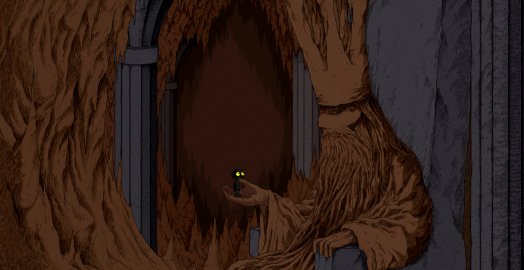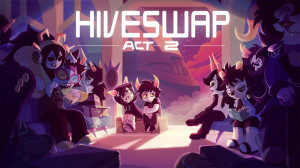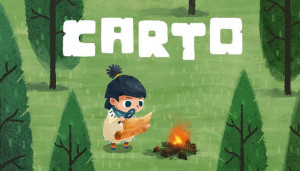Review for The Longing

Well. Here we are. As I write this it’s the beginning of 2021, and the world is holding its breath as vaccine distribution provides what seems like the first glimmer of light in the long darkness of the COVID-19 pandemic. For most of 2020 it felt like waiting was the only thing anybody could do, and it appears there’s still a good amount of it ahead of us, but for the first time in a long while there's reason to believe the end isn’t beyond imagining.
No one could have guessed, when The Longing was first announced, that it would be released into such a world. Back then it seemed like a novel idea likely to please a niche audience with an appetite for experimentation: a game that took place in real-time across 400 days, centered largely on being shut in, waiting for time to pass and finding ways to fill it. Its appeal was limited by design, and when I volunteered to review it I expected to mostly examine how (and if) its central conceit worked. What happened instead was that, between the initial announcement and launch, the prospect of asking players to face isolation, loneliness, and a possibly fruitless search for bright spots in the dark stopped being quite so risky and experimental. Our collective experience of this year-long nightmare all but ensures that such topics will be plumbed across all forms of media for years to come, and in a variety of different ways. What I’m here to tell you is that The Longing not only did it first, but got it right without a model to work from.
The Longing tells a simple story: you are a Shade, the last remaining subject of a weary king whose power is almost spent. With the last of his energy, your liege tasks you to act as steward of his underground realm while he retreats into a four-hundred-day slumber to recover his strength. When he awakens, he says, he will banish all longing from the world; until then, you’ll have to brave the darkness on your own. The game begins once he’s asleep, and you’ll receive no further instruction from there as to what you should do or how to do it. So long as you stay within the bounds of the king’s domain and are there to wake him when the time expires, he says, your time is yours to do with what you will. The game’s real-time mechanic ensures that you’ll have a great deal of it, too, with the clock counting down the seconds, minutes, hours and days even after you’ve logged off. It’s down to you to decide what to see and do; the king’s realm is vast, with many secrets to be uncovered, and nothing—save the exit—is explicitly off limits.
The game emphasizes choice as a core mechanic in a much different way from most character-driven adventures. There aren’t any branching paths or either/or choices to determine where the story goes; rather, you are empowered to essentially determine what kind of game you want The Longing to be. You can, of course, be a good little Shade and carry out your sacred trust, finding ways to cope with the time stretching out ahead of you in advance of the king’s awakening. The Shade has a threadbare little cave to call its own, adorned with some meager shelves and a humble fireplace, and you can make it your mission to turn the place into a comfortable home. There are plenty of resources and discarded treasures to be found in the kingdom’s many dark corners, and a number of them can be repurposed into furniture, decorations or recreational equipment. You can seek out tools to reshape your surroundings, look for ways to make your fires burn longer and warmer, or even scavenge art supplies with which to produce wall hangings.
The cozier and more homey you make your cave, the faster the timer moves while you’re inside, so that one second can become two, three, or more; it’s thus possible to run out the timer before four hundred days have actually passed, so long as you build a nice home and let the Shade spend time there. If that’s your style you might want to go hunting for old books to bring back and read in your armchair. There are many of these scattered around, and for the most part they’re full-length readable texts of public-domain classics, including novels, poetry collections and philosophical treatises. It’s entirely possible to treat this game as an elaborate interactive library, spending its entire runtime acquainting yourself with Melville and Nietzsche and leaving your cave only to track down more reading material.
If being a homebody doesn’t sound appealing, you can explore the length and breadth of the kingdom for its own sake instead. Those who do will be treated to some truly breathtaking artwork and environmental design as you cover the great distances between points of interest; the king’s realm feels like a living place, rich with history and the character of centuries. Everywhere are buttressed columns and crumbling architecture hewn from the stone of the caverns, a fusion of the natural and artificial that speaks to the central conflict of endurance versus entropy. The king himself, whose vast slumbering form you must pass when traveling to or from your cave, appears to have merged with the landscape, his stony crown reaching up to join with the stalactites above him.
The vast majority of the story is told through the environment, with very little real exposition, so it’s left to you to decide the significance of the details for yourself. What subjects walked these halls and grottoes before you? Where did they go? Who carved out these caverns, and why—have there been other kings before this one, or is he the first? And why, when he seems so far beyond earthly concerns, does the king keep treasure piled behind a sturdy crystal pane? The Shade doesn’t know, and you may never find out either. Part of the joy is simply in the wondering.
There are several ways to complete the game, not all of which require waiting out the clock. The Shade is vaguely aware of an exit from the kingdom that lies somewhere far above, and comments in subdued tones about what it might take to reach it. Can you find it and leave for the outside world, or did the king anticipate rebellion and put something in place to stop you? If you want to try to find out during your playthrough, the game will let you; if not, you don’t need to give it a second thought. (You might also wonder whether you could set your computer’s date and time forward and skip right to the end. All I’ll say on the subject is that no one can stop you from trying…)
After loneliness, size seems to be The Longing’s chief concern. The kingdom is huge, and traveling from point A to point B requires seeing every inch of the terrain along the way. The Shade’s flat-footed shuffle is the only speed available to you, and as there’s no fast travel option it can take several minutes to walk from one corner of the kingdom to another. The interface is one-button point-and-click: a single click causes the Shade to take one step forward, while double clicking somewhere will make it walk to that spot. There’s no readily available map, but the drop-down menu will let you “remember” a location as a snapshot which you can then select to start the Shade walking back there. You’re only allowed a certain number of remembered locations before you’ll have to start overwriting, though, so it’s best to be judicious with your choices. (There’s also at least one secret hidden away in the tunnels that can help you get your bearings, but you’ll have to find it on your own.)
All the time you’ll spend in the Shade’s company will afford you gradual insight into its situation and way of thinking; lacking anyone else to keep it company, it frequently speaks its sorrows, hopes and dreams aloud. Some of what it says can gently hint at things to look for in your travels, but more often they’ll simply be mournful musings on its lot in life. Once in a while it will question itself about its own feelings or what it should do next, and you’ll be prompted to select one of several replies. Your input in these “conversations” doesn’t seem to actually change anything except how the Shade tends to speak about itself, but they’re a helpful focusing tool for deciding on how you want to play. Speech is unvoiced, popping up in rectangular boxes with the speaker’s face displayed alongside and your available replies (if there are any) appearing below.
The soundtrack helps to bring the game’s sense of scale forward, with a synth-organ aesthetic that creates an atmosphere of almost religious awe. In some areas it’s backed by faint chanting reminiscent of a requiem mass, while in others it sinks to a low, funerary hum. The word epic has been overused to the point of near-meaninglessness by now, but it’s really the only word that fits here: the sweeping, orchestral-sounding instrumentals convey nothing so much as the feeling of size, perfectly complementing the cavernous, cathedralesque halls of the king’s central court and the endless waiting darkness of the adjacent tunnels. With the Shade’s tiny footsteps echoing just beneath it, the music is a constant reminder of how small you are in relation to the world around you, and the various tracks emphasize the simultaneous wonder, melancholy and terror accompanying such awareness. (Several of these are pre-existing pieces by established artists in the dungeon-synth scene, but they blend seamlessly with the rest of the music.)
Puzzles tend to be simple and mostly involve kickstarting processes that alter the environment and allow you access to new areas. You can climb and manipulate features like moss, stones and cobwebs to cross gaps or ascend rock faces (when the Shade comes alongside a hotspot, a clickable prompt appears telling you what you can do), but sometimes you’ll come to an area that’s presently impassable. Frequently you’ll have to move or place something there that you found elsewhere, so that it can grow larger or otherwise reshape its surroundings to be more maneuverable. There’s no manageable inventory, however; when the Shade finds a relevant object, it will either show back up in your cave to be used there or stay in reserve to be brought out in an appropriate spot. Usually the Shade will tell you how long you have to wait for a given process to finish, which can range from a few hours to a month.
The Longing has multiple endings available, each dependent on the courses of action you take throughout. I’m not sure of the exact number; the most I’ve heard mentioned is five, but the game is so stuffed with carefully hidden secrets that it wouldn’t surprise me if there were more waiting to be discovered. As you’re only allowed one playthrough at a time—with no saving necessary, since the game tracks your progress from start to finish—there’s no way to reach an ending and then go back to see the others without starting the whole game over again. This feels fully in keeping with the spirit of a game that offers no shortcuts except through hard work: your decisions are final, and the consequences are yours to endure.
Still, after spending so much time with the Shade, when my ending arrived it felt hurried in a way that nothing else had—almost an afterthought, even. I can’t speak to the other finales—and for what it’s worth, I believe mine is considered one of the “bad” endings—but this one didn’t feel as if it had been crafted with the meticulous, painstaking care evident everywhere else in the game. Good or bad, a story’s ending should feel as if it flows naturally from everything that came before, both a summing-up and a capping-off; other conclusions may accomplish this better than the one I got, but here at least the developers didn’t quite manage to stick the landing.
Normally one could look up alternate endings to see them all, but in this case, at least, I don’t think a summary or video replay would be enough to do them justice. Those other endings would have arisen out of different play-styles than the one I used, so without actually playing that way myself, I don’t think anything I might feel about them now would be at all meaningful. Consider this an account of my personal playthrough, and know that your experience could very well differ greatly from mine.
An entire year is a long time, and some feel much longer than others. I concluded my earlier mid-game article on The Longing as follows: “The Shade and I still have around two hundred days left in front of us. I don’t know what we’ll discover in that time or how the game world will change; the same, of course, is true of the world we live in.” That time has now passed, and while the Shade’s job is now done, you and I are still here. We can celebrate having made it this far through the pandemic; it wasn’t guaranteed. I’m a different person than I was, as I imagine you are as well, but my appreciation for The Longing and its accomplishments remains unchanged.
If you’ve been waiting all this time for my final verdict, it’s unequivocal: if you’re willing to devote the time, if you’re interested in a most unconventional type of gameplay, if you believe in games as an art form, if you’ve ever been lonely or had to fend for yourself in a world too big for you to comprehend, you should play this game. There’s perhaps no better endorsement I can offer than to say that, having invested this much time into The Longing, I fully intend to go back for another go-round; there are still secrets to be found and other methods of exploring I haven’t tried yet. I don't know what I'll discover or who I'll become by the time my next playthrough ends—however impossibly distant it may now seem—but I very much look forward to making the journey. Thank you for joining me on this one.
Our Verdict:
The Longing uses isolation, open space and freedom of choice to send players on a year-long exploration of loneliness, identity and meaning in real time. It won’t be to everybody’s taste, but those who commit to seeing it through will find a surprising, poignant and rewarding experience unlike anything else out there.












__medium.jpg)















